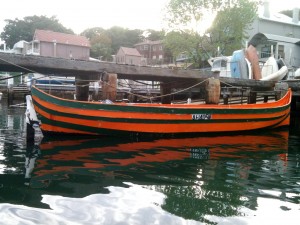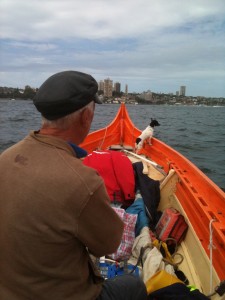This is Rob Tearne’s own boat that he built about 10 years ago and has been used as an every day knockabout workboat ever since. When it was about 5 years old he added another 7 ft in the middle so now she’s 25ft long.
Its a traditional scandinavian design rowing boat, and which I think makes an ideal candidate for electric propulsion. Rowing boats by nature have limited power of the human rower, and through generations of incremental improvement the design have evolved to be easily driven hull shapes. And it is with this norse design. It has a viking look about it with its upturned bow and stern and is modelled on the Oselvar style boat. The Oselvars have only three planks to form the hull but Rob has used more to make a smoother hull shape.
Despite being only a metre wide its really stable and the narrow beam helps to make her easily driven into wind and waves. This photo from on board was taken crossing Sydney Harbour from Kirribili to Rushcutters Bay.
We took some speed readings gin across to Rushcutters Bay and back. The motor was badly positioned for a number of reasons and I expect we could see at least a knot and maybe more by getting its angle and position right. The outboard well was designed for a 15 HP yamaha and it was such that the Torqeedo could not be positioned with the leg vertical – it had quite an angle to it and the thrust created rooster-tail of wash. As well it needs a long-shaft version to get the prop deep enough so that its not sucking air. By getting the angle right and the prop down so it is running in clear water this boat will perform much better.
We were using the standard prop on a Cruise 4 for the test. Top speed was 7.5 knots downwind and 6.4 knots against the wind and chop. As is usual in photos the chop always looks less than how it was. Here is a graph showing the readings of speed and power.





